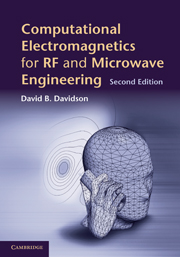Book contents
- Frontmatter
- Dedication
- Contents
- Preface to the second edition
- Preface to the first edition
- Acknowledgements
- To the reader
- List of notation
- 1 An overview of computational electromagnetics for RF and microwave applications
- 2 The finite difference time domain method: a one-dimensional introduction
- 3 The finite difference time domain method in two and three dimensions
- 4 A one-dimensional introduction to the method of moments: modelling thin wires and infinite cylinders
- 5 The application of the FEKO and NEC-2 codes to thin-wire antenna modelling
- 6 The method of moments for surface modelling
- 7 The method of moments and stratified media: theory
- 8 The method of moments and stratified media: practical applications of a commercial code
- 9 A one-dimensional introduction to the finite element method
- 10 The finite element method in two dimensions: scalar and vector elements
- 11 The finite element method in three dimensions
- 12 A selection of more advanced topics in full-wave computational electromagnetics
- Appendix A The Whitney element
- Appendix B The Newmark-β time-stepping algorithm References
- Appendix C On the convergence of the MoM Reference
- Appendix D Useful formulas for simplex coordinates
- Appendix E Web resources
- Appendix F MATLAB files supporting this text
- Index
- References
7 - The method of moments and stratified media: theory
Published online by Cambridge University Press: 05 July 2014
- Frontmatter
- Dedication
- Contents
- Preface to the second edition
- Preface to the first edition
- Acknowledgements
- To the reader
- List of notation
- 1 An overview of computational electromagnetics for RF and microwave applications
- 2 The finite difference time domain method: a one-dimensional introduction
- 3 The finite difference time domain method in two and three dimensions
- 4 A one-dimensional introduction to the method of moments: modelling thin wires and infinite cylinders
- 5 The application of the FEKO and NEC-2 codes to thin-wire antenna modelling
- 6 The method of moments for surface modelling
- 7 The method of moments and stratified media: theory
- 8 The method of moments and stratified media: practical applications of a commercial code
- 9 A one-dimensional introduction to the finite element method
- 10 The finite element method in two dimensions: scalar and vector elements
- 11 The finite element method in three dimensions
- 12 A selection of more advanced topics in full-wave computational electromagnetics
- Appendix A The Whitney element
- Appendix B The Newmark-β time-stepping algorithm References
- Appendix C On the convergence of the MoM Reference
- Appendix D Useful formulas for simplex coordinates
- Appendix E Web resources
- Appendix F MATLAB files supporting this text
- Index
- References
Summary
Introduction
Modelling stratified media is an important application of the MoM. A stratified medium is one consisting of homogeneous layers of material, each layer having different electromagnetic properties. This includes the general category of printed antennas, of which microstrip is the best known. (Microstrip technology is discussed in more detail in the next chapter.) It also brings with it the problem of dealing with dielectric materials. Central to this is the issue of the Green function for the problem. The MoM relies on an appropriate Green function as the “field propagator.” Due to its perceived complexity, the topic of stratified media is generally regarded as an advanced one, and the coverage tends to be highly theoretical, and frequently impenetrable without lengthy study. One reason for this is that, historically, analysis focussed on the problem of a dipole above a dielectric half-space. There are a number of complex issues which this raises, requiring quite sophisticated analytical techniques to understand, in particular for the asymptotic cases where interesting radiation physics can be extracted. However, the analysis of a very important special case, namely the grounded single-layer microstrip line (or patch antenna), can be undertaken without undue complexity, at least for most practical cases where the substrate is relatively thin.
In this chapter, a static analysis of a microstrip transmission line is first undertaken, to demonstrate the basic principles of the spectral domain and the derivation of the Green function.
- Type
- Chapter
- Information
- Computational Electromagnetics for RF and Microwave Engineering , pp. 264 - 299Publisher: Cambridge University PressPrint publication year: 2010



